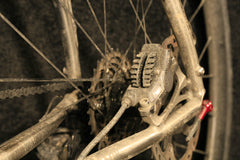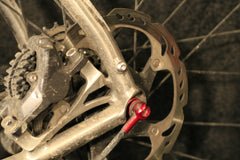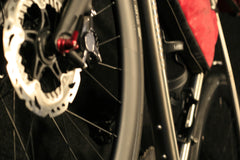Disc Brake Cleaning
Your stopping power is just as key to performance as a smooth running drivetrain. A poorly maintained braking system will not only increase your braking distances but is potentially dangerous.
Simple, effective maintenance and cleaning are all that’s needed. For the cleaning, we have Crankalicious’ Rotorissimo brake cleaner.

Consider 3 elements to cleaning bikes with disc brakes;
1) The rotors (the disc attached to your wheel)
2) The calipers (the bit the clamps the pads around the disc)
3) The levers and hydraulics
A cursory look at each one after a ride, and a weekly clean (mileage dependent, of course) is all that’s needed to keep your brakes looking good and working well.
To clean, remove both wheels. Check that each rotor is free from contaminants (such as caught stones and grit) and free from major damage, such as deep scratches or deformation. Spray a brake cleaner such as Rotorissimo directly onto the rotor. Use a cloth or brush to agitate and remove any remaining dirt, then finish with a cloth to remove last bits.
A brake cleaning product is designed to flash away, leaving no trace to ensure perfect, consistent braking. Be sure not to use products containing PTFE or gloss enhancing properties; the surface will remain slippery, thus affecting braking. If you accidentally overspray a lubricating product, simply use a brake cleaner again to remove it. If you find your brakes squeaking, cleaning the rotor in this way is often a good place to start.
With the wheels still removed, spray a brake cleaner generously over the calipers and unions (the bits that connect all the pipes together). Scrub with a brush or cloth, removing all the contaminants. Inside are many moving parts, that you want to be sure don’t have any dirt nearby that could work its way in. As above, the brake cleaning spray will flash away, leaving no trace.

Just as important a part of the braking system as the pads and rotors are the levers. Whether hydraulic or cable operated, clean the moving parts with brake cleaner and a brush or cloth. Ensure no grit within the mechanism. This time, be sure to lubricate afterwards; these are moving parts. Be careful though; don’t pull on the brake lever while the disc is not in place. You don’t want to compress the pads together without the disc in between - the pistons will overreach.
Remember to frequently check your brakes for abnormal wear, and with a sensible cleaning regime, they’ll serve you well. Ensure there’s no stones or grit stuck anywhere in the braking system, that the right parts are lubricated, and that importantly the wrong parts are not lubricated


